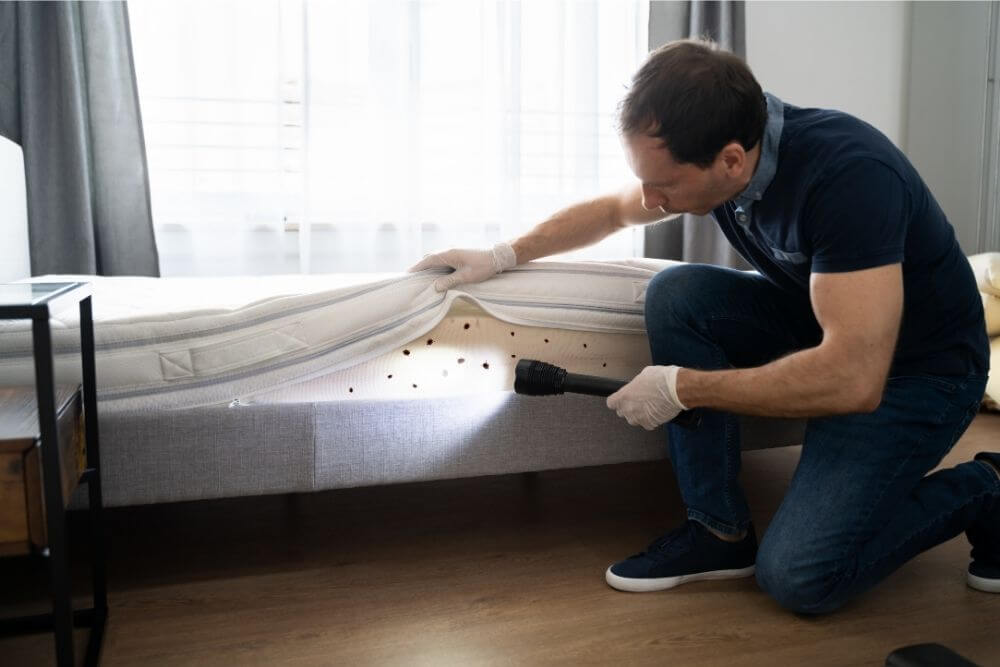
Attacks from bad mattress design can be difficult to deal with. But with the right methods, you can successfully rid your home of these pests. Bed bugs are resistant and might spread fast if not handled well. This article provides step-by-step steering on cleansing up after a bed bug infestation, emphasising the significance of bed bug treatment and the way to put together a plan for it.
What Are Bed Bugs?
Bed bugs are small, yellowish insects that feed on the blood of people and animals and regularly resemble apple seeds and may be covered in small cracks and crevices, making them difficult to come across in bedrooms most bed bugs are nocturnal, commonly on beds, and furnishings and different male-infested objects.
Signs of a Bed Bug Infestation
- Red, itchy bites on your skin, often in a line or cluster.
- Rusty or reddish stains on bed sheets or mattresses caused by crushed bed bugs.
- Small, dark spots (bed bug excrement) on sheets, mattresses, and walls.
- Eggs and Shells. Tiny, pale yellow eggs and shed skins in hidden areas.
Step-through-Step Guide to Cleaning Up a Bed Bug Infestation
Step one – prepare the area
Before beginning your bed bug treatment, it’s important to prepare the infested area. Declutter and remove unnecessary items from the room. Keep in mind that bed bugs can hide in a mess, which makes it difficult to treat the infestation. Consider carefully cleaning all your house.
Step two – launder clothing and bedding
Bed bugs and their eggs can hide in fabric, so laundering all clothing and bedding is essential. Wash all clothing, bedding, and linens in hot water (at least 120°F) to kill bed bugs and their eggs. Dry items on the highest heat setting for at least 30 minutes. Store cleaned items in sealed plastic bags or containers until the infestation is completely eradicated.
Step three – vacuum thoroughly
Vacuuming is an effective method for removing bed bugs and their eggs from surfaces:
- Mattresses and Furniture. Use a vacuum cleaner with a hose attachment to Hoover mattresses, field springs, bed frames, and furniture very well. Pay unique interest to seams, crevices, and folds.
- Carpets and Rugs. Vacuum carpets and rugs, specifically along the rims where bed bugs are probably to hide.
- Remove the vacuum bag – right away, seal the vacuum bag in a plastic bag and take it away from your own home to prevent similar buildup.
Step four – kill mattress bugs and their eggs with cold water
Steam cleaning has a terrific capacity to kill bed insects and their eggs on contact. Use a steam cleaner to deal with mattresses, upholstered fixtures, and other fabric gadgets till the steam reaches a temperature of at least seventy one°C. This temperature kills the bed bugs successfully and isn’t dangerous for an individual given that it will likely be brief till bed insects are lifeless and the temperature will get colder. Move the steam cleaner slowly to ensure the heat penetrates deeply into the fabric and crevices.
Step five – apply insecticides
Using insecticides can help eliminate any remaining bed bugs and prevent future infestations. Select insecticides specifically labelled for bed bug treatment and look for products containing pyrethroids, neonicotinoids, or insect growth regulators (IGRs). Apply insecticides according to the manufacturer’s instructions, focusing on cracks, crevices, and other hiding spots. Multiple treatments may be necessary to eradicate the infestation, and follow-up treatments should be performed every two weeks until bed bugs are no longer detected.
Step six – encase mattresses and box springs
Encasements can trap any remaining bed bugs and prevent them from spreading. Purchase bedbug-proof encasements for your mattresses and box springs. These encasements should be tightly sealed with no openings. Keep the encasements on for at least a year to ensure any remaining bed bugs are trapped and eventually die off.
Step seven – dispose of infested items properly
In a few cases, it could be vital to take away closely infested objects:
- Seal Before Disposal. Before doing away with infested items from your home, seal them in plastic baggage to prevent bed insects from spreading.
- Label Items. Clearly label infested items to warn others and save you from the spread of mattress insects.
The Importance of Thoroughness and Bed Bug Treatment
Bed bugs are notoriously hard to eliminate, and a single, not noted spot can result in re-infestation. Consistency and thoroughness in your bed bug treatment efforts are critical.
Continue to look at your house frequently for signs and symptoms of bed insects, even after remedy. Early detection can assist save you a new infestation from taking preserves.
For extreme infestations or if DIY methods are not effective, don’t forget to hire expert pest control services and bed bug treatment. Bed bug pest control corporations have the information and system to deal with infestations more effectively than the owners of the household.
Conclusion
Cleaning up a bed bug infestation requires a scientific and thorough method. By following this step-by-step manual, you may successfully eliminate mattress insects and their eggs from your home.
Key steps consist of laundering garb and bedding in hot water, vacuuming mattresses and furniture, using steam to kill mattress insects, and applying insecticides. Remember to be thorough in your cleaning efforts and dispose of infested objects nicely. Seal Items – place infested items in sealed plastic bags to prevent bed bugs from spreading to other areas of your home.
If the infestation persists, don’t hesitate to search for help from mattress bug manipulation organisations and bed bug pest control experts like Fantastic Pest Control. With diligence and the proper strategies, you may reclaim your own home from these chronic pests. If you can’t handle this better, consider calling a pest control expert and bed bug treatment experts.




